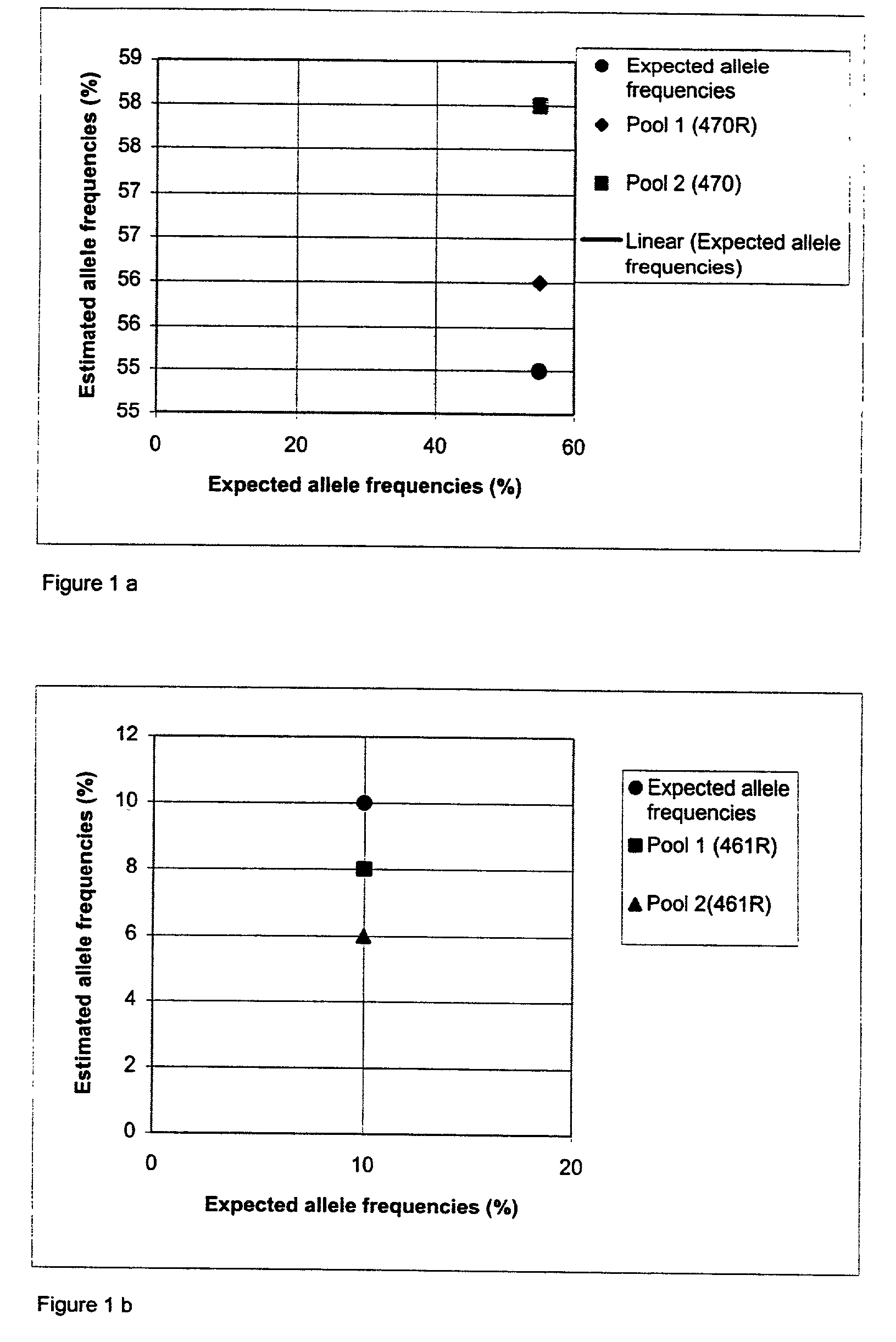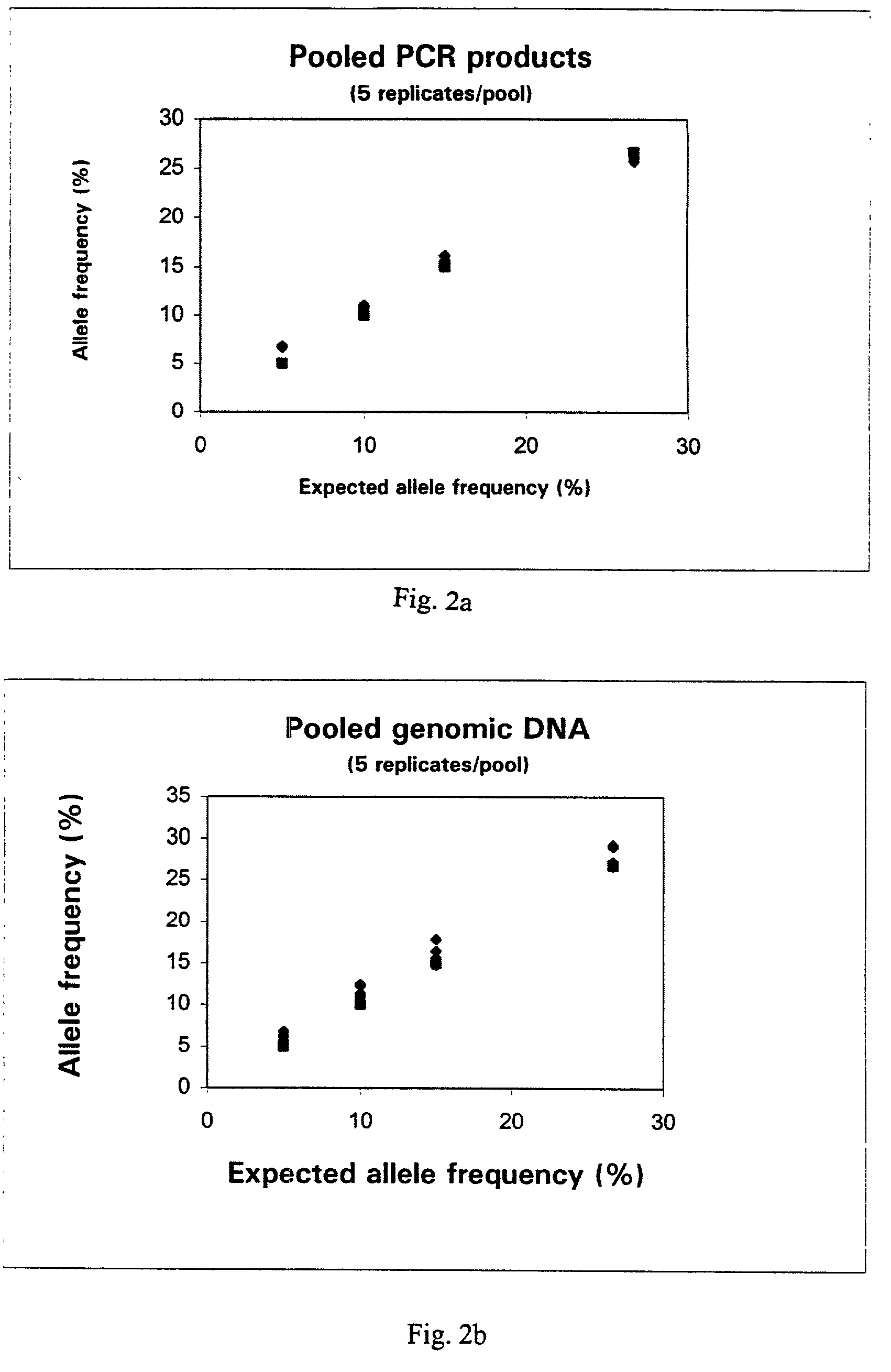Method for determining allele frequencies
- Summary
- Abstract
- Description
- Claims
- Application Information
AI Technical Summary
Benefits of technology
Problems solved by technology
Method used
Image
Examples
example 1
Templates and Primers
[0136]These examples used DNA from 3 different sources which was either extracted from cell lines or from genomic sources. In total, DNA from 122 individual sources was used. The concentration of nucleic acid in some of the samples had been determined previously by measurement of absorbance at a wavelength of 260 nm. These samples were diluted to 2 ng / μl based on the absorbance measurements and the samples were either pooled directly, or after concentration calibration.
[0137]Some examples were performed on template oligonucleotides instead of PCR products. These oligonucleotides were obtained from Interactiva Ulm, Germany.
[0138]PCR amplification primers and sequencing primers were designed using Oligo 6.0 (Med Probe AS, Oslo, Norway). All primers were ordered from Interactiva (Supra).
[0139]
TABLE 1Primers and SNP definitionsUpstreamDownstreamSequencingFragmentSequencingSNP_IDprimerprimerprimerlength [bp]outputEu1E1aE1bE1s158A / T(ACP-240)(SEQ ID NO: 3)(SEQ ID NO: 4...
example 2
DNA Calibration
[0144]In order to calibrate the amount of DNA in each of the samples, an SNP was chosen for analysis. SNP 465R was chosen, it is a C / T SNP that generates good signals without preferential amplification, is not present in a homopolymeric stretch and gives no background signals or uneven peak heights. All samples were genotyped for the chosen SNP.
[0145]
TABLE 3Primers used to amplify and sequence SNP 465R.SNPDownstreamSequencingFragmentSequencingIDUpstream primerprimerprimer lengthSNPoutput465R5-B-gga aca ctg cct5-tcc cca tgc agc5-gga gaa gtc85G / AC / Tccc act ttc tt-3′cct aga gac-3cag tgt gc-3(SEQ ID NO: 16)(SEQ ID NO: 17)(SEQ ID NO: 18)
[0146]The genotyping was performed as follows. 5 μl genomic DNA (at a concentration of approximately 2 ng / μl) was amplified as described previously in Example 1. 25 μl of the PCR product was mixed with 8 μl magnetic beads Dynabeads® (Dynal Biotech ASA, Oslo, Norway) (10 μg / μl) and 17 μl 2×BW buffer (10 mm Tris-HCl, 2M NaCl, 1 mM EDTA, 0.1% ...
example 3
SNP Analysis Protocol
[0174]The pooled DNA (calibrated according to Example 2, or of known concentration) was added to 45 μl PCR mix (supra) and amplified as described previously. 25 μl of the PCR product was mixed with 8 μl magnetic beads—Dynabeads® (Dynal Biotech ASA, Oslo, Norway) (10 μg / μl) as described in Example 2. Annealing of the primer to the template DNA was performed with 15 pmol sequencing primer, for 2 minutes at 80 C. The samples were allowed to cool to room temperature and the primer extension reaction was performed on a PSQ™ 96 instrument (Pyrosequencing AB) using SNP reagent kit (Pyrosequencing AB). Once the peak height data was collected for the DNA pool, the allele frequency can be calculated as follows if the SNP is not present in a homopolymeric stretch:—
[0175]PeakHeight(Allele2)PeakHeight(Allele2)+PeakHeight(Allele1)×100%
PUM
| Property | Measurement | Unit |
|---|---|---|
| Molar density | aaaaa | aaaaa |
| Molar density | aaaaa | aaaaa |
| Fraction | aaaaa | aaaaa |
Abstract
Description
Claims
Application Information
 Login to View More
Login to View More - R&D
- Intellectual Property
- Life Sciences
- Materials
- Tech Scout
- Unparalleled Data Quality
- Higher Quality Content
- 60% Fewer Hallucinations
Browse by: Latest US Patents, China's latest patents, Technical Efficacy Thesaurus, Application Domain, Technology Topic, Popular Technical Reports.
© 2025 PatSnap. All rights reserved.Legal|Privacy policy|Modern Slavery Act Transparency Statement|Sitemap|About US| Contact US: help@patsnap.com



